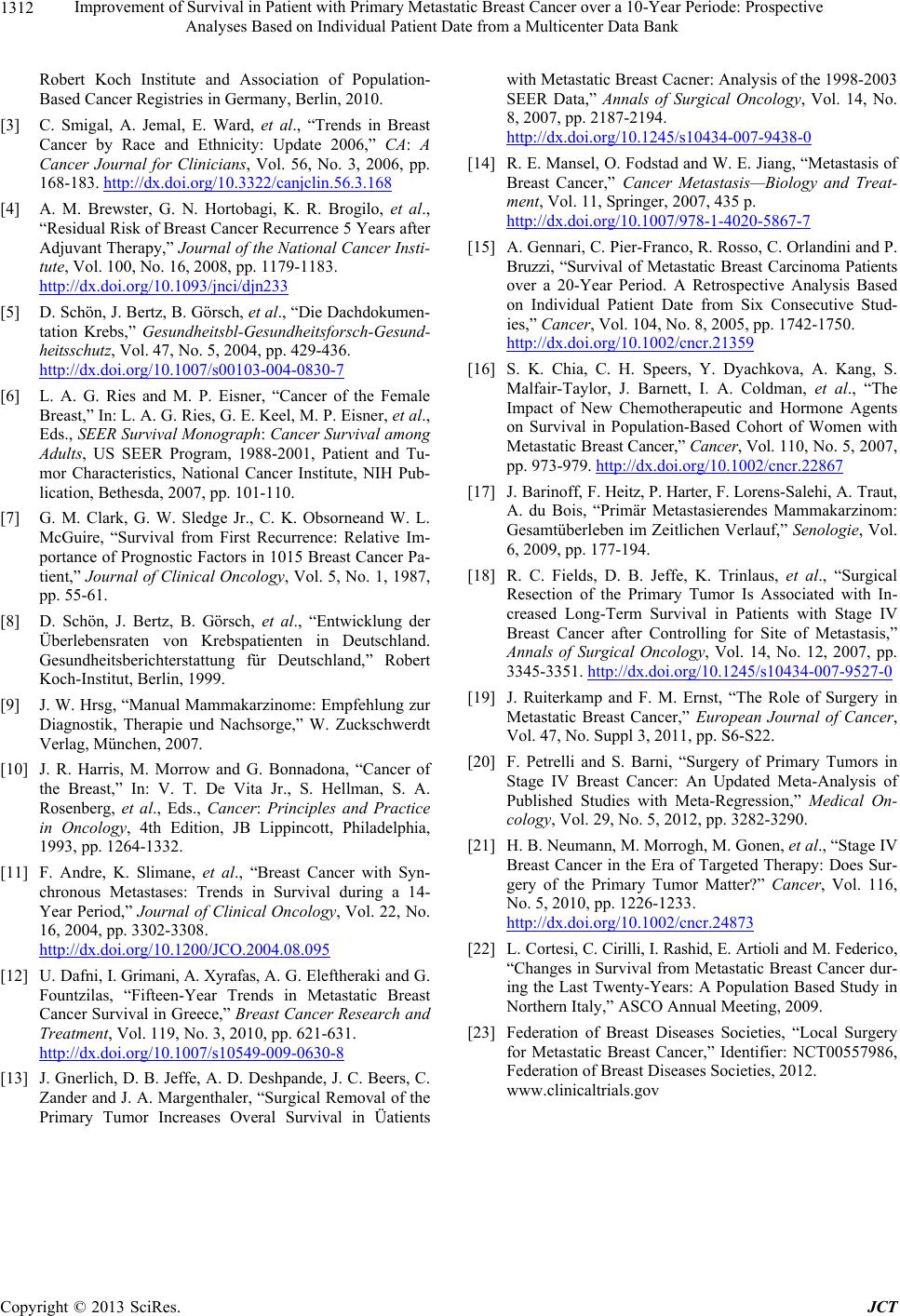
Improvement of Survival in Patient with Primary Metastatic Breast Cancer over a 10-Year Periode: Prospective
Analyses Based on Individual Patient Date from a Multicenter Data Bank
1312
Robert Koch Institute and Association of Population-
Based Cancer Registries in Germany, Berlin, 2010.
[3] C. Smigal, A. Jemal, E. Ward, et al., “Trends in Breast
Cancer by Race and Ethnicity: Update 2006,” CA: A
Cancer Journal for Clinicians, Vol. 56, No. 3, 2006, pp.
168-183. http://dx.doi.org/10.3322/canjclin.56.3.168
[4] A. M. Brewster, G. N. Hortobagi, K. R. Brogilo, et al.,
“Residual Risk of Breast Cancer Recurrence 5 Years after
Adjuvant Therapy,” Journal of the National Cancer Insti-
tute, Vol. 100, No. 16, 2008, pp. 1179-1183.
http://dx.doi.org/10.1093/jnci/djn233
[5] D. Schön, J. Bertz, B. Görsch, et al., “Die Dachdokumen-
tation Krebs,” Gesundheitsbl-Gesundheitsforsch-Gesund-
heitsschutz, Vol. 47, No. 5, 2004, pp. 429-436.
http://dx.doi.org/10.1007/s00103-004-0830-7
[6] L. A. G. Ries and M. P. Eisner, “Cancer of the Female
Breast,” In: L. A. G. Ries, G. E. Keel, M. P. Eisner, et al.,
Eds., SEER Survival Monograph: Cancer Survival among
Adults, US SEER Program, 1988-2001, Patient and Tu-
mor Characteristics, National Cancer Institute, NIH Pub-
lication, Bethesda, 2007, pp. 101-110.
[7] G. M. Clark, G. W. Sledge Jr., C. K. Obsorneand W. L.
McGuire, “Survival from First Recurrence: Relative Im-
portance of Prognostic Factors in 1015 Breast Cancer Pa-
tient,” Journal of Clinical Oncology, Vol. 5, No. 1, 1987,
pp. 55-61.
[8] D. Schön, J. Bertz, B. Görsch, et al., “Entwicklung der
Überlebensraten von Krebspatienten in Deutschland.
Gesundheitsberichterstattung für Deutschland,” Robert
Koch-Institut, Berlin, 1999.
[9] J. W. Hrsg, “Manual Mammakarzinome: Empfehlung zur
Diagnostik, Therapie und Nachsorge,” W. Zuckschwerdt
Verlag, München, 2007.
[10] J. R. Harris, M. Morrow and G. Bonnadona, “Cancer of
the Breast,” In: V. T. De Vita Jr., S. Hellman, S. A.
Rosenberg, et al., Eds., Cancer: Principles and Practice
in Oncology, 4th Edition, JB Lippincott, Philadelphia,
1993, pp. 1264-1332.
[11] F. Andre, K. Slimane, et al., “Breast Cancer with Syn-
chronous Metastases: Trends in Survival during a 14-
Year Period,” Journal of Clinical Oncology, Vol. 22, No.
16, 2004, pp. 3302-3308.
http://dx.doi.org/10.1200/JCO.2004.08.095
[12] U. Dafni, I. Grimani, A. Xyrafas, A. G. Eleftheraki and G.
Fountzilas, “Fifteen-Year Trends in Metastatic Breast
Cancer Survival in Greece,” Breast Cancer Research and
Treatment, Vol. 119, No. 3, 2010, pp. 621-631.
http://dx.doi.org/10.1007/s10549-009-0630-8
[13] J. Gnerlich, D. B. Jeffe, A. D. Deshpande, J. C. Beers, C.
Zander and J. A. Margenthaler, “Surgical Removal of the
Primary Tumor Increases Overal Survival in Üatients
with Metastatic Breast Cacner: Analysis of the 1998-2003
SEER Data,” Annals of Surgical Oncology, Vol. 14, No.
8, 2007, pp. 2187-2194.
http://dx.doi.org/10.1245/s10434-007-9438-0
[14] R. E. Mansel, O. Fodstad and W. E. Jiang, “Metastasis of
Breast Cancer,” Cancer Metastasis—Biology and Treat-
ment, Vol. 11, Springer, 2007, 435 p.
http://dx.doi.org/10.1007/978-1-4020-5867-7
[15] A. Gennari, C. Pier-Franco, R. Rosso, C. Orlandini and P.
Bruzzi, “Survival of Metastatic Breast Carcinoma Patients
over a 20-Year Period. A Retrospective Analysis Based
on Individual Patient Date from Six Consecutive Stud-
ies,” Cancer, Vol. 104, No. 8, 2005, pp. 1742-1750.
http://dx.doi.org/10.1002/cncr.21359
[16] S. K. Chia, C. H. Speers, Y. Dyachkova, A. Kang, S.
Malfair-Taylor, J. Barnett, I. A. Coldman, et al., “The
Impact of New Chemotherapeutic and Hormone Agents
on Survival in Population-Based Cohort of Women with
Metastatic Breast Cancer,” Cancer, Vol. 110, No. 5, 2007,
pp. 973-979. http://dx.doi.org/10.1002/cncr.22867
[17] J. Barinoff, F. Heitz, P. Harter, F. Lorens-Salehi, A. Traut,
A. du Bois, “Primär Metastasierendes Mammakarzinom:
Gesamtüberleben im Zeitlichen Verlauf,” Senologie, Vol.
6, 2009, pp. 177-194.
[18] R. C. Fields, D. B. Jeffe, K. Trinlaus, et al., “Surgical
Resection of the Primary Tumor Is Associated with In-
creased Long-Term Survival in Patients with Stage IV
Breast Cancer after Controlling for Site of Metastasis,”
Annals of Surgical Oncology, Vol. 14, No. 12, 2007, pp.
3345-3351. http://dx.doi.org/10.1245/s10434-007-9527-0
[19] J. Ruiterkamp and F. M. Ernst, “The Role of Surgery in
Metastatic Breast Cancer,” European Journal of Cancer,
Vol. 47, No. Suppl 3, 2011, pp. S6-S22.
[20] F. Petrelli and S. Barni, “Surgery of Primary Tumors in
Stage IV Breast Cancer: An Updated Meta-Analysis of
Published Studies with Meta-Regression,” Medical On-
cology, Vol. 29, No. 5, 2012, pp. 3282-3290.
[21] H. B. Neumann, M. Morrogh, M. Gonen, et al., “Stage IV
Breast Cancer in the Era of Targeted Therapy: Does Sur-
gery of the Primary Tumor Matter?” Cancer, Vol. 116,
No. 5, 2010, pp. 1226-1233.
http://dx.doi.org/10.1002/cncr.24873
[22] L. Cortesi, C. Cirilli, I. Rashid, E. Artioli and M. Federico,
“Changes in Survival from Metastatic Breast Cancer dur-
ing the Last Twenty-Years: A Population Based Study in
Northern Italy,” ASCO Annual Meeting, 2009.
[23] Federation of Breast Diseases Societies, “Local Surgery
for Metastatic Breast Cancer,” Identifier: NCT00557986,
Federation of Breast Diseases Societies, 2012.
www.clinicaltrials.gov
Copyright © 2013 SciRes. JCT